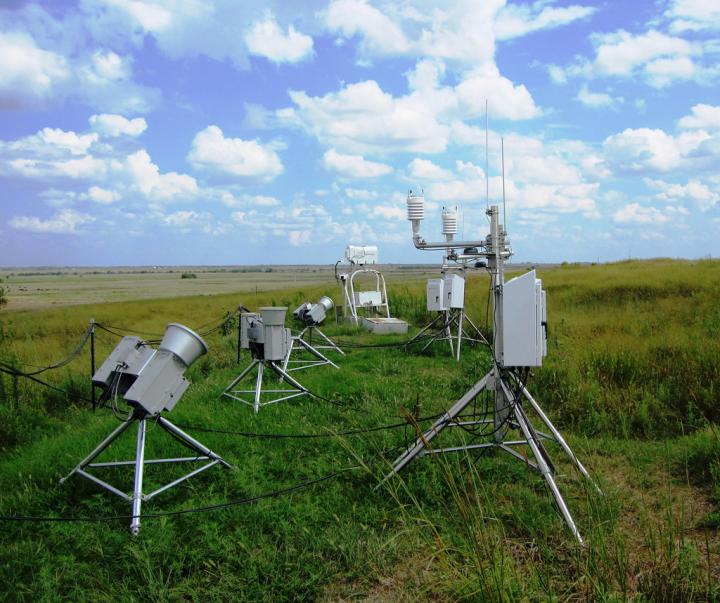First direct observations of methane's increasing greenhouse effect at the Earth's surface

The scientists used radiometers, shown here, to isolate the signal of methane's greenhouse effect. Radiometers are among the many instruments at ARM's Southern Great Plains observatory that the team utilized as part of this study. Credit: ARM Climate Research Facility
These findings were published online April 2 in the journal Nature Geoscience in an article entitled “Observationally derived rise in methane surface forcing mediated by water vapour trends.” The paper indicates that the greenhouse effect from methane tracked the global pause in methane concentrations in the early 2000s and began to rise at the same time that the concentrations began to rise in 2007.
“We have long suspected from laboratory measurements, theory, and models that methane is an important greenhouse gas,” said Berkeley Lab Research Scientist Dan Feldman, the study's lead author. “Our work directly measures how increasing concentrations of methane are leading to an increasing greenhouse effect in the Earth's atmosphere.”
Gases that trap heat in the atmosphere are called greenhouse gases, in large part because they absorb certain wavelengths of energy emitted by the Earth. As their atmospheric concentrations change, the scientific community expects the amount of energy absorbed by these gases to change accordingly, but prior to this study, that expectation for methane had not been confirmed outside of the laboratory.
The scientists analyzed highly calibrated long-term measurements to isolate the changing greenhouse effect of methane. They did this by looking at measurements over the wavelengths at which methane is known to exert its greenhouse effect and coupled those with a suite of other atmospheric measurements to control for other confounding factors, including water vapor.
This study was enabled by the comprehensive measurements of the Earth's atmosphere that the DOE has routinely collected for decades at its Atmospheric Radiation Measurement (ARM) facilities, and conversely, would not be possible without such detailed observations.
The DOE ARM program manages and supports three long-term atmospheric observatories – the Southern Great Plains observatory in Oklahoma, the North Slope of Alaska observatory in far-northern Alaska, and the Eastern North Atlantic observatory on the Azores Islands. The program also deploys three ARM mobile facilities and several ARM aerial facilities. Together, these assets enable scientists to perform highly-detailed, targeted investigations to advance the fundamental scientific understanding of the Earth system.
The researchers believe this type of direct field observation can provide a more accurate and complete picture of the relationship between atmospheric greenhouse gas concentrations and their warming effect on Earth's surface.
###
The research was funded by the Department of Energy's Office of Science.
Lawrence Berkeley National Laboratory addresses the world's most urgent scientific challenges by advancing sustainable energy, protecting human health, creating new materials, and revealing the origin and fate of the universe. Founded in 1931, Berkeley Lab's scientific expertise has been recognized with 13 Nobel Prizes. The University of California manages Berkeley Lab for the U.S. Department of Energy's Office of Science. For more, visit http://www.
DOE's Office of Science is the single largest supporter of basic research in the physical sciences in the United States, and is working to address some of the most pressing challenges of our time. For more information, please visit science.energy.gov.
Media Contact
More Information:
https://www.eurekalert.org/pub_releases/2018-04/dbnl-fdo033018.phpAll latest news from the category: Earth Sciences
Earth Sciences (also referred to as Geosciences), which deals with basic issues surrounding our planet, plays a vital role in the area of energy and raw materials supply.
Earth Sciences comprises subjects such as geology, geography, geological informatics, paleontology, mineralogy, petrography, crystallography, geophysics, geodesy, glaciology, cartography, photogrammetry, meteorology and seismology, early-warning systems, earthquake research and polar research.
Newest articles

Properties of new materials for microchips
… can now be measured well. Reseachers of Delft University of Technology demonstrated measuring performance properties of ultrathin silicon membranes. Making ever smaller and more powerful chips requires new ultrathin…

Floating solar’s potential
… to support sustainable development by addressing climate, water, and energy goals holistically. A new study published this week in Nature Energy raises the potential for floating solar photovoltaics (FPV)…

Skyrmions move at record speeds
… a step towards the computing of the future. An international research team led by scientists from the CNRS1 has discovered that the magnetic nanobubbles2 known as skyrmions can be…




















